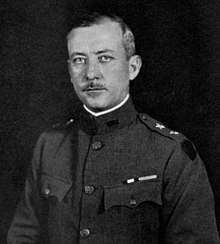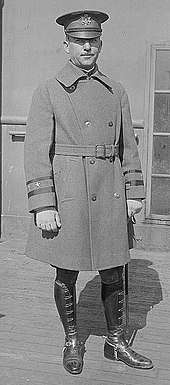John F. O'Ryan
John Francis O'Ryan (August 21, 1874 - January 29, 1961) was a Manhattan, New York City attorney, politician, government official and military officer. He served as commander of the 27th Division during World War I. He later served as a member of the New York State Transit Commission and as New York City Police Commissioner. During World War II he was New York State Civil Defense Director.
John Francis O'Ryan | |
|---|---|
 John F. O'Ryan as commander of the 27th Division in World War I | |
| Born | August 21, 1874 Manhattan, New York City, New York |
| Died | January 29, 1961 (aged 86) South Salem, New York |
| Place of burial | |
| Allegiance | |
| Service/ | |
| Years of service | 1898-1920 |
| Rank | |
| Commands held |
|
| Battles/wars |
|
| Awards | Distinguished Service Medal |
| Other work |
|
Early career

O'Ryan was born in New York City on August 21, 1874. He attended the public schools of New York City, City College of New York and the law program of New York University, and became an attorney in 1898. He enlisted in the New York National Guard while still a college student and received his commission as a Second Lieutenant in 1900.[1]
In 1912 O'Ryan was appointed Major General and commander of the New York National Guard.[2] He graduated from the Army War College in 1914 and served in the 1916 Villa Expedition.[3][4]
In 1914 O'Ryan received his law degree from New York University School of Law as a member of the class of 1896.[5]
World War I

At the start of World War I the New York National Guard was organized as the 27th Division with O'Ryan as commander. The 27th saw action in Belgium and France, and O'Ryan, the Army's youngest division commander when he arrived in Europe, was the only National Guard general to remain in command throughout the war. After returning to the United States O'Ryan was a founder of the American Legion.[6]
Post-World War I
From 1922 to 1926 he was a member of the New York State Transit Commission.[7] In 1926 he became prominent in the development of commercial aviation as a partner in Pan American Airways, later becoming President of Colonial Airlines.[8][9]
In 1933 O'Ryan led parades protesting the treatment of Jews in Germany and advocating for the U.S. government to intervene on their behalf.[10][11]
In 1934 he was a Republican candidate for Mayor of New York, but withdrew in favor of Fiorello LaGuardia. When LaGuardia won, O'Ryan accepted appointment as his Police Commissioner. O'Ryan served for most of 1935 before resigning over disagreement with LaGuardia's non-intervention stance on labor-management disputes.[12][13][14]
World War II
In 1940 O'Ryan led a study group in Japan and occupied China, with the knowledge of President Franklin D. Roosevelt. The committee, which included economists Warren S. Hunsberger and Simon N. Whitney, were invited by the Japanese Economic Federation and the New York investment firm of Eastman Dillon and Company to research ways to improve trade relations between Japan and the U.S. so that Japan might become a U.S. ally. While in Japan, O'Ryan learned that the Japanese government planned to sign the Tripartite Pact with Fascist Italy and Nazi Germany. O'Ryan and his group submitted their report to the Japanese Economic Federation and returned home.[15][16]
During the war he served as New York State's Civil Defense Director and was also an unofficial advisor to Secretary of War Henry L. Stimson. In 1945 he was elected National Commander of the Military Order of Foreign Wars and, on December 7, 1945, visited President Truman at the White House on to pay his respects.[17]
Awards
O'Ryan's awards included the Distinguished Service Medal and the Victory Medal. He received the following foreign decorations: British Order of St. Michael and St. George (Knight Commander); British Royal Victorian Order (Commander); French Legion of Honor (Commander); French Croix de Guerre with Palm; Belgian Order of Leopold (Commander); Belgian Croix de Guerre with Palm; and Italian Order of Saints Maurice and Lazarus.[18]
In 1919 O'Ryan received an honorary Doctor of Laws (LL.D.) from New York University.[19]
Death and burial
General O'Ryan died in South Salem, New York on January 29, 1961.[20] He was buried at Arlington National Cemetery, Section 2, Site E-17 LH.[21]
Legacy
In 1952 a New York National Guard training area in Wethersfield, New York was dedicated in his honor, Camp O'Ryan. It had been used as a training site beginning in 1949, and remained in use until 1974. It was returned to use in 1989, and was inactivated in 1994.[22]
See also
- Yockelson, Mitchell A. (2008-05-30). Borrowed Soldiers: Americans under British Command, 1918. Foreword by John S. D. Eisenhower. University of Oklahoma Press. ISBN 978-0-8061-3919-7.
References
- O'Ryan's Roughnecks, Biography, John F. O'Ryan, retrieved June 19, 2014
- New York State Senate, Journal of the Senate of the State of New York, 1912, page 79.
- New York Adjutant General, Annual Report, 1916, page 69
- Albert Bushnell Hart, editor, Harper's Pictorial Library of the World War, The 27th Division in France, Volume 5, 1920, page 281
- New York University, Catalogue of New York University, 1916, page 579
- Anne Cipriano Venzon, editor, The United States in the First World War: An Encyclopedia, 2013, pages 424-425
- New York State Transit Commission, Reports of Decisions of the Transit Commission of the State of New York, Volume 1, 1921, title page
- F. Robert Van der Linden, Airlines and Air Mail: The Post Office and the Birth of the Commercial Aviation Industry, 2002, page 23
- Flying magazine, Advertisement, Fairchild Industries, October 1928, page 3
- Richard Breitman, FDR and the Jews, 2013, unknown page number
- Michael Zalampas, Adolf Hitler and the Third Reich in American Magazines, 1923-1939, 1989, page 32
- Frank Donner, Protectors of Privilege: Red Squads and Police Repression in Urban America, 1992, page 381
- H. Paul Jeffers, The Napoleon of New York: Mayor Fiorello La Guardia, 2002, page 162
- Thomas Reppetto, American Police: A History, 1845-1945, 2010, pages 1931-1933
- O'Ryan Off for Japan on Economic Mission; General Heads Committee to Spur Trade Relations, New York Times, June 10, 1940
- Haruo Iguchi, Unfinished Business: Ayukawa Yoshisuke and U.S.-Japan Relations, 1937-1953, pages 125-, 291
- Truman Library, Calendar for December 7, 1945, retrieved June 18, 2014
- O'Ryan's Roughnecks, Biography, John F. O'Ryan, retrieved June 19, 2014
- Henry Blaine Davis, Generals in Khaki, 1998, page 289
- Annual Report 1961, (New York) Division of Military and Naval Affairs, Governor Nelson A. Rockefeller - Commander in Chief, Maj. Gen. A. C. O'Hara - Chief of Staff - New York Army National Guard - New York Naval Militia - New York Air National Guard - New York Guard
- Arlington National Cemetery, Gravesite Locator, retrieved June 20, 2014
- U.S. Army Corps of Engineers, Formerly Used Defense Sites (FUDS), Fact Sheet - Camp O'Ryan/Wethersfield Training Area, February, 2013
External links
- Oryan Roughnecks
- Digger History
- ARMY COURT DEALS SWIFT PUNISHMENT - July 22, 1916
- O'Ryan, World War General, Registers as Japanese Agent; The Washington Post; July 16, 1940
- O'Ryan Japanese Economic Mission History
- More on history of O'Ryan Japanese Economic Mission
- O'RYAN OFF FOR JAPAN ON ECONOMIC MISSION; General Heads Committee to Spur Trade Relations, New York Times, June 10, 1940
- Gen. O'Ryan Dead; Headed the 27th, New York Times, Jan 31, 1961 article
- John F. O'Ryan at Find a Grave
| Military offices | ||
|---|---|---|
| Preceded by New post |
Commanding General 27th Division 1917–1918 |
Succeeded by Post deactivated |
| Police appointments | ||
| Preceded by James S. Bolan |
NYPD Commissioner 1934 |
Succeeded by Lewis Joseph Valentine |